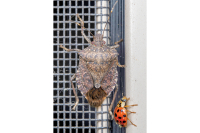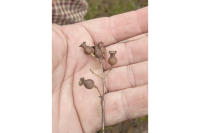Cherokee and their bird stories
The second soul, that of physiological life, is located in the liver, and is of primary importance in doctoring and in conjuring. This soul is a substance, is not anthropomorphic in any, has no individuality, and is quantitative, there is more or less of it. Its secretions are yellow bile, black bile, gastric juice, etc. Destruction of the liver substance produces lassitude, the “yellows” (jaundice or hepatitis, or cirrhosis) or the “black” (deep depression or gall bladder attacks or acute pancreatitis). Exhaustion of the liver substance (absence of the soul) produces physiological death. This soul may be attacked by the conjuror, producing false “yellows” or “black” as “simulation diseases,” reproducing the symptoms of witch-attack, or it may be actually consumed by witches to produce the standard form of liver-gall-pancreas diseases. The witch lengthens its life by extra supplies of liver-soul.
— Frans M. Olbrechts, editor, “The Swimmer Manuscript” (1932).
The bird life of the southern mountains played a central role in Cherokee lore. Many of the legends anthropologist James Mooney recorded in the late 1880s, when he visited the Qualla Boundary, depicted their activities. According to Mooney’s Myths of the Cherokees (1900), birds (“jisgwa”) inhabited the spiritual Upper World in the Cherokee cosmos by the obvious reason of their ability to fly. Their general superiority over the quadrupeds and other inhabitants of the Middle World (the everyday, mundane world to which humans are confined) is demonstrated in many of the stories.
In times of peace, the Cherokees flew a white flag or white-dressed deerskin at the top of a long white pole. Just below this white emblem they painted or carved the image of a bird.
When a baby girl was born, the birds sang happily as they knew she would eventually feed them with grains of corn that were scattered as she made flour. But when a baby boy was born, the birds went into mourning since they would surely hunt them with blowguns.
Related Items
Two of the most common birds that the early Cherokees observed year round — just as we do today — were the chickadee (“tsikilili,” a word that imitates the bird’s call) and the tufted titmouse (“utsugi,” a word that means “topknot” in reference to its crested head).
Paraphrasing Mooney’s words, which he recorded after listening to the legends recited by the great shaman Swimmer and others, I’ll relate for you their tale regarding the chickadee and the titmouse so that when you observe these birds at your feeders this winter you’ll be sure to see them in a different light.
The chickadee and the titmouse belong to the same scientific family of birds (“Paridae”), so it’s not surprising that they are about the same size and act in much the same fashion. Indeed, in winter, they hang out together in loose, noisy flocks that forage from tree to tree through the woodlands, with the noisy — not to say brash, titmice generally in the lead.
The Cherokees trusted the more docile chickadee, sensing that it was an honest messenger that accurately foretold the coming of an absent friend or unknown stranger or even an enemy. The somewhat larger and much more saucy titmouse they considered to be a false messenger. It was, for them, “the bird that lies.”
These characteristics were embodied in their myth about a terrible ogress named “Utlunta” or “Spear-finger.” She could assume any shape or appearance but generally appeared as an old woman, “excepting that her whole body was covered with a skin as hard as a rock that no weapon could wound or penetrate, and that on her right hand she had a long, stony forefinger of bone, like an awl or spearhead, with which she stabbed everyone to whom she got near enough.” Then she would use her long bone-tipped finger so as to extract her victims’ livers.
At long last, the Indians trapped Spear-finger in a deep pitfall, “but shoot as true and as often as they could, their arrows struck the stony mail of the witch only to be broken and fall useless at her feet, while she taunted them and tried to climb out of the pit to get at them.”
After awhile, a titmouse came along that, without hesitation, informed them in no uncertain terms that the only vulnerable part of the witch was her heart. But, alas, their “arrows only glanced off with the flint heads broken.” Enraged, the Indians caught the titmouse and cut most of its tongue off, “so that ever since its tongue is short and everybody knows it is a liar.”
Finally, just as the witch was about to make her escape, a chickadee appeared from out of nowhere. The little bird alighted upon the witch’s right hand, which was where her evil heart was actually located. A swift arrow directed at Spear-finger’s hand pierced the vital organ. Snarling in agony, she fell dead.
Since that time, chickadees have been honored by the Cherokees as “truth tellers.” Their close observations of the basic demeanors of these closely related birds resulted in the traits they associated with each. These they cunningly wove into the Spear-finger legend, along with elements concerning their beliefs about the soul and its residing place.
George Ellison wrote the biographical introductions for the reissues of two Appalachian classics: Horace Kephart’s Our Southern Highlanders and James Mooney’s History, Myths, and Sacred Formulas of the Cherokees. In June 2005, a selection of his Back Then columns was published by The History Press in Charleston as Mountain Passages: Natural and Cultural History of Western North Carolina and the Great Smoky Mountains. Readers can contact him at P.O. Box 1262, Bryson City, N.C., 28713, or at This email address is being protected from spambots. You need JavaScript enabled to view it..













